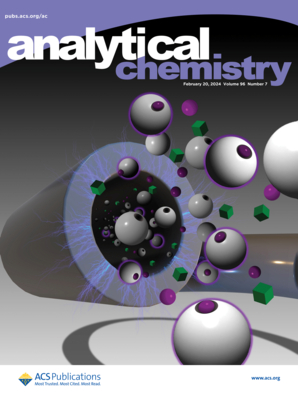高效电化学发光的环保型二氧化锰量子点用于肝癌标志物的超敏检测。
IF 6.7
1区 化学
Q1 CHEMISTRY, ANALYTICAL
引用次数: 0
摘要
本文首次提出了高效环保的MnO2量子点(MnO2 QDs)作为电化学发光(ECL)发射体,构建了一种超灵敏检测肝癌标志物microRNA-222 (miRNA-222)的生物传感器。与已有报道的含重金属元素量子点相比,MnO2量子点不仅具有显著的ECL效率,而且具有良好的生物相容性,在生物传感器领域具有广阔的应用前景。银纳米粒子(Ag NPs)作为助反应加速剂可以促进反应物S2O82-转化为丰富的SO4•-,从而产生更多的MnO2量子点*,显著提高MnO2量子点的ECL效率。此外,利用DNAzyme特异性切割双环发夹并释放靶类似物,建立了一种高效的DNAzyme诱导自反馈DNA扩增(DISFA)策略,实现了痕量miRNA-222转化为丰富的输出DNA,提高了扩增效率和检测灵敏度。由MnO2 QDs/S2O82-/Ag NP三联体系和DISFA策略组成的ECL生物传感器对miRNA-222在100 aM至100 pM具有良好的线性响应,检测限为12.90 aM (S/N = 3),成功地应用于癌细胞(MHCC-97L和HeLa)溶出物中miRNA-222的分析。本研究提出了具有良好生物相容性的过渡金属氧化物量子点(TMO量子点)作为高效稳定的ECL发射体,用于生物标志物的敏感检测,在疾病诊断方面具有巨大的潜力。本文章由计算机程序翻译,如有差异,请以英文原文为准。
Environment-Friendly MnO2 Quantum Dots with Highly Efficient Electrochemiluminescence for Ultrasensitive Assay of Liver Cancer Markers.
In this work, environment-friendly MnO2 quantum dots (MnO2 QDs) with high efficiency were first proposed as electrochemiluminescence (ECL) emitters to construct a biosensor for ultrasensitive detection of microRNA-222 (miRNA-222) related to liver cancer markers. Compared with reported QDs containing heavy metal elements, MnO2 QDs not only exhibited remarkable ECL efficiency but also displayed the advantage of good biocompatibility, showing promising application prospects in the biosensor field. Impressively, silver nanoparticles (Ag NPs) as coreaction accelerators could promote the conversion of the coreactant S2O82- into abundant SO4•- to produce more MnO2 QDs* to significantly enhance the ECL efficiency of MnO2 QDs. Furthermore, an efficient DNAzyme-Induced Self-Feedback DNA Amplification (DISFA) strategy was developed by employing DNAzyme to specifically cleave double-loop hairpins and release target analogues, achieving the conversion of trace miRNA-222 into abundant output DNA and improving the amplification efficiency and detection sensitivity. The ECL biosensor composed of a MnO2 QDs/S2O82-/Ag NP ternary system and DISFA strategy displayed an excellent linear response of miRNA-222 from 100 aM to 100 pM with a low detection limit of 12.90 aM (S/N = 3) and was successfully implemented for the analysis of miRNA-222 in cancer cell (MHCC-97L and HeLa) lysates. This study proposed transition metal oxide QDs (TMO QDs) with good biocompatibility as efficient and stable ECL emitters for the sensitive detection of biomarkers, demonstrating immense potential for disease diagnosis.
求助全文
通过发布文献求助,成功后即可免费获取论文全文。
去求助
来源期刊

Analytical Chemistry
化学-分析化学
CiteScore
12.10
自引率
12.20%
发文量
1949
审稿时长
1.4 months
期刊介绍:
Analytical Chemistry, a peer-reviewed research journal, focuses on disseminating new and original knowledge across all branches of analytical chemistry. Fundamental articles may explore general principles of chemical measurement science and need not directly address existing or potential analytical methodology. They can be entirely theoretical or report experimental results. Contributions may cover various phases of analytical operations, including sampling, bioanalysis, electrochemistry, mass spectrometry, microscale and nanoscale systems, environmental analysis, separations, spectroscopy, chemical reactions and selectivity, instrumentation, imaging, surface analysis, and data processing. Papers discussing known analytical methods should present a significant, original application of the method, a notable improvement, or results on an important analyte.
 求助内容:
求助内容: 应助结果提醒方式:
应助结果提醒方式:


